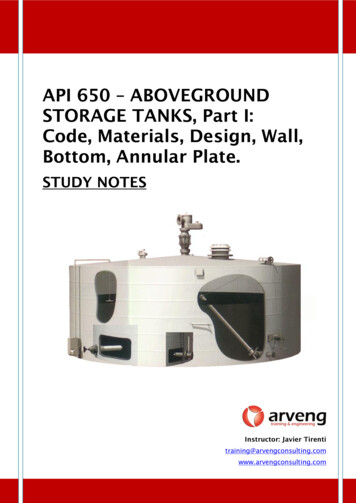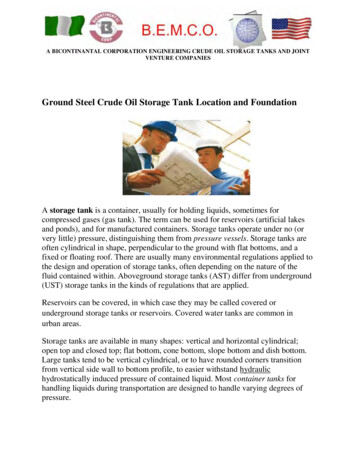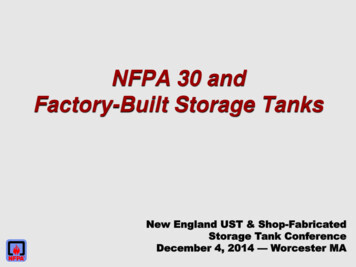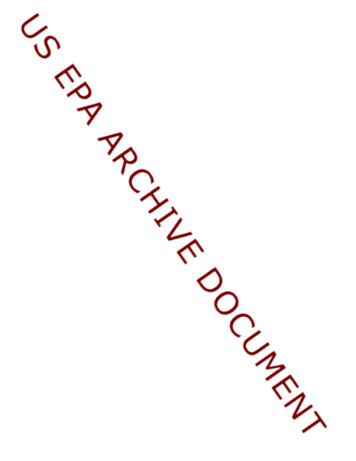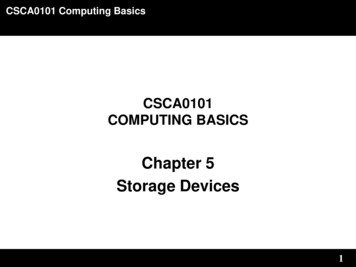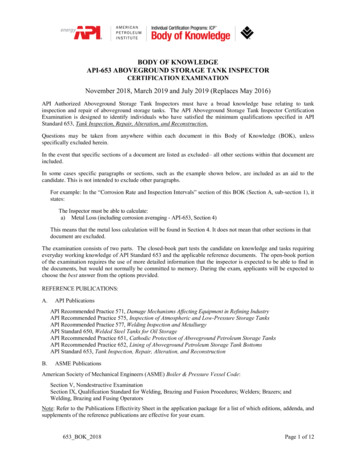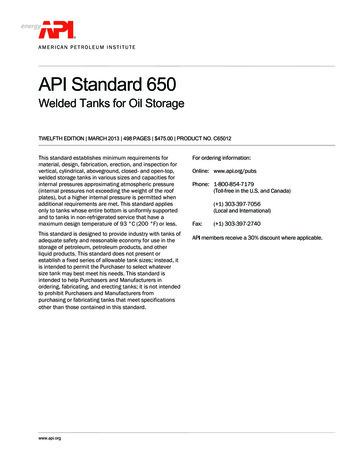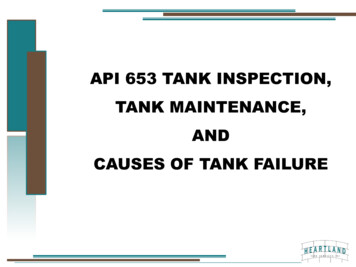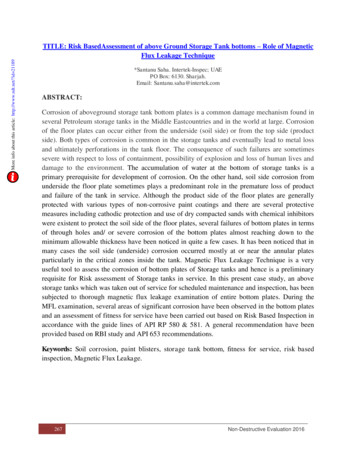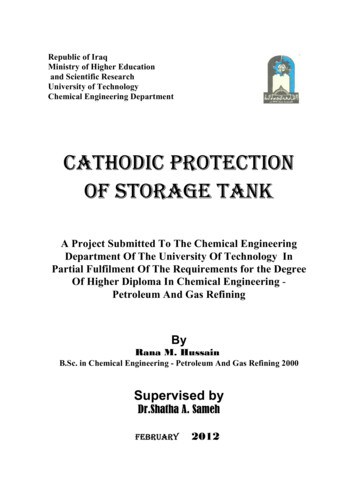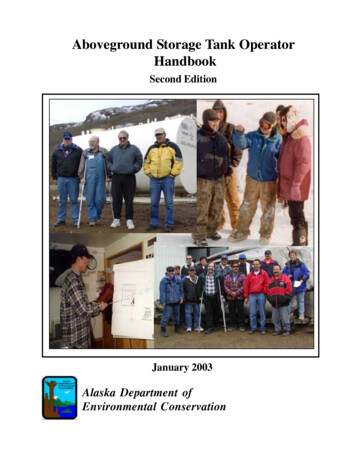
Transcription
Aboveground Storage Tank OperatorHandbookSecond EditionJanuary 2003Alaska Department ofEnvironmental Conservation
AST Operator Handbook, First EditionINTRODUCTION & TABLE OF CONTENTSOil spills are ugly, costly and can damage our health and the environment.In Alaska, thousands of gallons of oil and oil products are spilled everyyear at Aboveground Storage Tank (AST) facilities. Most of these spills arecaused by operator error, poor operation practices and inadequate maintenance. In order to reduce the number and size of spills at these facilities,operators should be trained in facility operations and maintenance, safety,spill preparedness, spill response, reporting, clean-up and government requirements.This handbook is designed for AST operators and should be used as aguidebook as well as a reference manual.In this handbook you will find:Facilities Tank Farms Step by step procedures for maintaining and inspecting AST facilities, preventing oil spills, taking safety precautions, preparing for andresponding to oil spills. Checklists for easy reference to inspect AST facilities, transfer fuel,prepare for and respond to spills. An explanation of government requirements relating to AST facilities. References and contacts for further information on AST facilitiesJanuary 2003INTRODUCTION Introduction, Page 1
AST Operator Handbook, First EditionINTRODUCTION & TABLE OF CONTENTSSection One - Facility Opetations & MaintenancePageAboveground Storage Tank Facilities. 2Aboveground Storage Tanks. 4Facility Piping. 6TABLE OF CONTENTSSecondary Containment . 8Ancillary Equipment.10Spill Prevention. 12Causes of Oil Spills at AST Facilities. 13Prevention Measures. 15AST Facility Maintenance .16AST Facility Inspections. 19Transfer Procedures. 28Inventory Control. . 35Section Two - SafetyFire and Explosions. 2General Facility Safety . 2Personal Safety. 3First Aid. 4Introduction, Page 2January 2003
AST Operator Handbook, First EditionINTRODUCTION & TABLE OF CONTENTSSection Three - Spill PreparednessPageFacility Analysis and Inspection . 2Spill Response Equipment and Materials . 4Spill Response Equipment Checklist . 5Spill Response Materials Checklist . 6Spill Response Plans . 8Local Response Agreements . 9Example Response Container Inventorytory.10Section Four - Spill Response & ReportingTABLE OF CONTENTSOperator Preparedness Training . 7Detecting Oil Spills . 2Where Spills are Likely to Happen . 3Spill Response . 4Spill Reporting . 10Spill Response Checklist . 11Section Five - Government RequirementsState and Federal Regulatory Agency Overview. 2January 2003Introduction, Page 3
AST Operator Handbook, First EditionINTRODUCTION & TABLE OF CONTENTSEnvironmental Protection Agency . 4United States Coast Guard . 9Alaska Department of Public Safety (Fire Marshall). 11Alaska Department of Environmental Conservation . 12TABLE OF CONTENTSAppendix A - Industry StandardsIndustry Standards - General Information. 2Addresses for Industry Standards . 3Industry Standards for Facility Piping . 5Industry Standards for Tank Design & Construction .6Industry Standards for Tank Operation . 9Industry Standards for AST Maintenance .11Fire Protection . 12AST Related Industry Standards . 13Appendix B - Materials Safety Data SheetTexaco Diesel #2.2Chevron Unleaded Gas .5Appendix C - SPCC PlansSPCC Plan Instructions .2Introduction, Page 4January 2003
AST Operator Handbook, First EditionINTRODUCTION & TABLE OF CONTENTSTABLE OF CONTENTSSample SPCC Plan .17Appendix D - Operations ManualOperations Manual Completion Guidelines.2U.S. Coast Guard Response Plan Checklist.22Appendix E - GlossaryTABLE OF CONTENTSJanuary 2003Introduction, Page 5
FACILITYOPERATIONS&MAINTENANCESECTION ONE - FACILITY OPERATIONS & MAINTENANCESECTION ONE
AST Operator Handbook, First EditionSECTION 1 - FACILITY OPERATIONS & MAINTENANCESection One Table of ContentsPageAboveground Storage Tank Facilities. 2Aboveground Storage Tanks. 4Facility Piping. 6Ancillary Equipment. .10Spill Prevention. 12Causes of Oil Spills at AST Facilities. 13Prevention Measures. 15AST Facility Maintenance .16AST Facility Inspections. 19Transfer Procedures. 28Inventory Control. 35January, 2003SECTION ONE - TABLE OF CONTENTSSecondary Containment . 8Section 1, Page 1
AST Operator Handbook, First EditionABOVEGROUND STORAGE TANK FACILITIESSECTION 1 - FACILITY OPERATIONS & MAINTENANCEAn Aboveground Storage Tank (AST) Facility or tank farm consists of tanks(including day tanks), piping, secondary containment and ancillary equipment. These facilities are used to store fuel that will be dispensed at the site,delivered elsewhere, or transferred to other locations such as day tanks. Thismanual is directed toward AST facilities that are regulated by the Environmental Protection Agency (EPA) but not necessarily by the Alaska Department of Environmental Conservation (ADEC). EPA regulates facilities thathave a storage capacity of 1,320 gallons or more and ADEC regulates facilitieswith a storage capacity of 420,000 gallons or more.Section 1, Page 2January, 2003
AST Operator Handbook, First EditionSECTION 1 - FACILITY OPERATIONS & MAINTENANCEABOVEGROUND STORAGE TANK FACILITIESJanuary, 2003Section 1, Page 3
AST Operator Handbook, First EditionSECTION 1 - FACILITY OPERATIONS & MAINTENANCEABOVEGROUND STORAGE TANKSAboveground Storage Tanks Aboveground Storage Tanks (ASTs) come in many different sizes. Most ASTs have cylindrical sides or shells and flat tops and bottoms.They are set vertically (on end) or horizontally (on sides). Most ASTs are constructed out of steel. Older tanks have riveted orbolted seams and newer tanks are welded. Fuel storage tanks must be vented so fumes can escape, reducing thepotential for ruptures and collapses. ASTs should have cathodic protection, such as sacrificial anodes, toreduce corrosion. To reduce the chances for corrosion, tanks should be placed on a pad,foundation or supports rather than directly on the ground. Tanks should be painted with a light color and rust free. Tanks should be labeled as to contents, size, last internal inspection,safe gauge height and year built. Tanks must be have overfill protection, this would be direct visiongauges, high liquid level alarms , flow restrictions or high liquid levelshut-off devices. See Appendix A for additional technical information.Horizontal ASTVertical ASTDouble-walled ASTSection 1, Page 4January, 2003
AST Operator Handbook, First EditionSECTION 1 - FACILITY OPERATIONS & MAINTENANCEAboveground Storage Tanks - common featuresABOVEGROUND STORAGE TANKS10,000 gallonsUNLEADED GASOLINEConfinedSpaceFlex pipe*Often fill pipe is used as the discharge pipe as well and there is not aseparate discharge pipe.January, 2003Section 1, Page 5
AST Operator Handbook, First EditionSECTION 1 - FACILITY OPERATIONS & MAINTENANCEAST Facility PipingPiping is used to transfer fuel from the delivery source, such as barges orAST FACILITY PIPINGtrucks to the ASTs at the facility (transfer or fill piping), between tanks anddispensing pump (manifold piping), and from facility tanks to other associated tanks and other sources (distribution piping). Following is some basicinformation regarding facility piping: Pipes should be constructed out of steel and joints welded. Pipes are buried or aboveground. Aboveground piping should besupported up off the ground and protected from moving vehiclessuch as trucks and snowmobiles as well as falling snow and ice. Buriedpipes must be wrapped or coated for corrosion protection. Valves control the flow of oil between tanks and other tanks,delivery barges and other sources. The most common type of valvesare ball valves and gate valves. Using a single common transfer pipeline for different products is acommon practice. The U.S. Coast Guard requires that transfer piping must be hydrostatically tested annually. Water should be used for this test at 1.5times the allowable pressure. Since this is not always practical, productor air is often used. If product or air is used, the owner/operator mustrequest (in writing) permission from the Captain of the Port. Appendix A contains additional technical information.Section 1, Page 6January, 2003
AST Operator Handbook, First EditionSECTION 1 - FACILITY OPERATIONS & MAINTENANCEAST Facility PipingAST FACILITY PIPINGJanuary, 2003Section 1, Page 7
AST Operator Handbook, First EditionSECTION 1 - FACILITY OPERATIONS & MAINTENANCESecondary ContainmentSECONDARY CONTAINMENTThe purpose of secondary containment is to prevent petroleum productsfrom flowing onto the land or into the water should there be a spill at anAST facility. Spill containment measures, including secondary containment are required by the Environmental Protection Agency (EPA) at ASTfacilities as well as in areas of fuel transfer from tank trucks. Secondarycontainment: Must be large, high and strong enough to hold the contents of thelargest tank plus 10% for local precipitation. Must be constructed or lined with material that will hold petroleumproducts and prevent them from seeping into the ground. The liner should be covered with sand or gravel to prevent rippingand to provide protection from the weather. Double walled aboveground storage tanks are not required to belocated within a secondary containment area provided they have aa high liquid level alarm, and a flow restrictor or automatic shut offdevice References for additional technical information can be found inAppendix A.Double-walled tankSelf-diked tankSection 1, Page 8January, 2003
AST Operator Handbook, First EditionSECTION 1 - FACILITY OPERATIONS & MAINTENANCESecondary ContainmentSECONDARY CONTAINMENTJanuary, 2003Section 1, Page 9
AST Operator Handbook, First EditionSECTION 1 - FACILITY OPERATIONS & MAINTENANCEANCILLARY EQUIPMENTAside from the major components of an Aboveground Storage Tank Facility,additional items and equipment are required. Following is a list of ancillaryequipment:Fencing: AST facilities must have fences and gates that can belocked. The purpose of the fence is to keep unauthorized people,vandals and animals out.ANCILLARY EQUIPMENT Lighting: AST facilities must have sufficient lighting to prevent vandalism and help detect spills at night. Signs: “No-smoking” signs must be posted around the facility so theycan be seen from every side of the tank farm. Also “Danger”, “Warning” or “Authorized Personnel Only” signs must be posted to warnunauthorized individuals from entering the facility.Section 1, Page 10January, 2003
AST Operator Handbook, First EditionSECTION 1 - FACILITY OPERATIONS & MAINTENANCEANCILLARY EQUIPMENTANCILLARY EQUIPMENTJanuary, 2003Section 1, Page 11
AST Operator Handbook, First EditionSECTION 1 - FACILITY OPERATIONS & MAINTENANCESpill PreventionSPILL PREVENTIONThere are many reasons for preventing oil from spilling or leaking ontothe ground and into the waters of the state. Some basic reasons forpreventing oil spills are: Reduces potential for health problems Reduces risks to the environment Saves money from lost product, fines and clean-up costs Saves reputationsEvery drop of oil spilled has an impact on the environment and costsmoney. This is clearly demonstrated in the following table.OIL LOSS BY DRIPS AND DROPSRATE1 drop/10 second1 drop/5 seconds1 drop/second3 drops/secondStream - breaksinto dripsGAL./YEAR Cost @ 2.00/gal CONTAMINATEDSOIL (tons)CONTAMINATEDSOIL (Cubic yards)40804101,200 80.00 160.00 820.00 2,400.00150 tons300 tons1,500 tons4,500 tons270 yd³540 yd³2,700 yd³8,100 yd³8,600 17,200.0032,000 tons57,600 yd³1 drop 11/64 inch diameter 1.8tons per cubic yardSection 1, Page 12January, 2003
AST Operator Handbook, First EditionSECTION 1 - FACILITY OPERATIONS & MAINTENANCECauses of Oil Spills at AST FacilitiesSpills and leaks happen at Aboveground Storage Tank (AST) facilities forseveral reasons. Some causes are:Operator errorTanks overfilled Valves left open Poor transfer procedures Lack of product monitoring Potential problems not recognized Poor maintenance practicesPoorly designed or improperly installed facilities Inadequate security – vehicular traffic, children or vandals restrictedarea Facility located in flood zone or avalanche zone or any other areawhere natural disasters are likely to happen Falling snow and ice from tanks onto pipingCAUSES OF OIL SPILLS AT AST FACILITIES Storage Tank Problems Tank design and construction Inadequate foundation or tanks setting directly on the ground Tank bottom and seams rusted, shell pitted, weeping or leaking Improper ventingJanuary, 2003Section 1, Page 13
AST Operator Handbook, First EditionSECTION 1 - FACILITY OPERATIONS & MAINTENANCECauses of Oil Spills at AST Facilities (continued)CAUSES OF OIL SPILLS AT AST FACILITIESFacility Piping Problems Piping installed without considering traffic area Threaded joints rather than welded Inadequate pipe support – sagging pipe is prone to cracking (threadedjoints are particularly vulnerable) Valves not in good working order or corroded Pipe lying directly on ground – easily damaged Piping leaking or rusted from acidic soil No flex piping Pipes not hydrostatically tested annuallySecondary Containment Problems No dikes or secondary containment around tank farm Inadequate secondary containment – should be able to hold contentsof largest tank plus 10% for local precipitation Containment unable to hold spilled product Holes or low areas in dikes Water pooled in secondary containment area Holes and rips in linersSection 1, Page 14January, 2003
AST Operator Handbook, First EditionSECTION 1 - FACILITY OPERATIONS & MAINTENANCEPrevention MeasuresSpill Prevention Measures - Oil spills at AST facilities can be prevented.Following are some basic prevention measures:Note: “There is no such thing as a leak too small to fix” Train employees in correct operating procedures and spill prevention, preparedness and response Absolutely no alcohol or drugs at the facility Adopt a product inventory program and reconcile product andinventory data on a regular basis Establish and adhere to regular maintenance schedules Conduct routine standardized inspections, record findings and takefollow-up corrective actions Plan and design facility to industry standards (Appendix A) Take pride and responsibility in your AST facilityJanuary, 2003PREVENTION MEASURES Section 1, Page 15
AST Operator Handbook, First EditionSECTION 1 - FACILITY OPERATIONS & MAINTENANCEAST Facility MaintenanceRoutine inspections and maintenance are the two most important factors inpreventing oil spills and leaks at AST facilities. Inspections are covered onpages 17-25.General AST Facility maintenance should include the following:AST FACILITY MAINTENANCE1.4.5.Good house keeping: It is essential that the entire AST facility bekept clean and free of unnecessary items. An AST facility is designedto store petroleum products so only items that are directly related tothe operation of the facility should be stored there.Safety: Fire extinguishers must be kept pressurize andshould be shaken every month. All other safety equipmentmust be in good working order.3.Security: Any holes in fence, locks on gatesand burned out light bulbs should be repairedor replaced as soon as the deficiency is noted.Aboveground Storage Tanks: Keep ASTs in sound condition.a.Follow manufacturer instructions or industry standards formaintaining vents, overfill devices, gauges, corrosion protection,water drains and other items associated with tanks.b.Keep tanks painted in a light color to minimize fuel expansionand to reduce corrosion and tank disintegration.c.Repair tanks as soon as problems are noted.d.Make sure signs on tanks are visible and legible.Facility piping: Piping must be maintained in sound condition.a.Section 1, Page 162.Follow manufacturer instructions or industry standards formaintaining valves and corrosion protection devices.January, 2003
AST Operator Handbook, First EditionSECTION 1 - FACILITY OPERATIONS & MAINTENANCEAST Facility Maintenance (continued)7.Change filters on a regular basis using set procedures.c.Hydrostatically test transfer piping yearly. Use water andhold it at 1.5 times the normal operating pressure. If usingwater is not feasible, approval from the U.S. Coast Guard touse product or air is required.d.Rewrap or repaint pipes when coating, wrapping or paint iswearing through or chipping .e.Repair or replace valves and/or pipes as soon as possibleafter problems are noted.f.Replace threaded pipe with welded pipe whenever possible.g.Protect piping from traffic as much as possibleSecondary Containment: Keep the secondary containment areaclear of debris, unnecessary items, snow, ice and standing water.a.Remove snow, taking care not to tear the liner. If shoveling theentire area isn’t feasible, keep area around piping clean.b.Remove water, if a sheen is visible, put water through a fuelwater separator, not directly into the environment.c.Remove vegetation, keep weeds, willows and trees out ofsecondary containment area.d.If tears in liner are noticed, repair them as soon as possible.AST FACILITY MAINTENANCE6.b.Spill Preparedness and Response: Keep response equipment accessible and in good working condition.a.If emergency pumps and/or skimmers are kept at the site,start them up at least once a month.January, 2003Section 1, Page 17
AST Operator Handbook, First EditionSECTION 1 - FACILITY OPERATIONS & MAINTENANCEAST Facility Maintenance (continued)b.AST FACILITY MAINTENANCE8.Section 1, Page 18Response equipment and material must be kept readily available, easy to get at and in good condition.Record Keeping - Records of all activities pertaining to the facilityshould be kept on location, these include but are not limited to: Copies of Inspections!Operator inspections!Government Inspections Maintenance Records!Any major work done at the facility!Hydrostatic test results!As-built facility plans Operator training reports Reports of Oil Spills at the Facility!Where the spill occurred!When the spill occurred!Amount spilled!Clean up procedures used Fuel Inventory Records Government required documents, including:!Spill Prevention Control and Countermeasure (SPCC)Plans (EPA)!Facility Response Plans (EPA, USCG)!Letter of Intent to Operate (USCG)!Operation Manual (USCG)!Declaration of Inspection (USCG)!Spill Notification Placard (ADEC)January, 2003
AST Operator Handbook, First EditionSECTION 1 - FACILITY OPERATIONS & MAINTENANCEAST Facility InspectionsInspectors: Must be knowledgeable of facility components, operations,spill prevention, preparedness and response and government requirements.How to Conduct Inspections: When conducting the more formal andthorough inspection, the inspector should use the following protocol: Use a checklist to make sure all important areas are covered. AnAST Facility Inspection Form, which may be copied for your use,is included on pages 26-27. This form may be revised to meet theneeds of individual AST facilities. Complete the inspection form, writing down findings and conditionsand be sure to initial, date and sign the form where indicated. Follow up on findings!Fix deficiencies!Report significant problems to managementAST FACILITY INSPECTIONSAn aboveground storage tank (AST) facility inspection isone of the best means of preventing oil spills from occurring and minimizing the size of a spill should one occur.Inspections should be conducted on a regular basis in astandardized fashion. At manned facilities, informal inspections should be done on a daily basis (noting overall facility condition)when the operator walks through to open and close the facility. A moreformal and thorough inspection should be completed monthly.The inspection: Following is a detailed description of what to look for inroutine, monthly AST facility inspections:1.Housekeeping: Is the AST facility clean and clear of unnecessaryitems? It is important to keep facilities clean and free of unnecessaryitems because clutter would hinder clean-up in the event of a leak orspill; large items such as drums, lumber and other objects can breakpipes, dent tanks and provide homes for unwanted animals. PoorJanuary, 2003Section 1, Page 19
AST Operator Handbook, First EditionSECTION 1 - FACILITY OPERATIONS & MAINTENANCEAST Facility Inspections (continued)housekeeping is a sign of negligence and shows a lack of concern forthe facility.AST FACILITY INSPECTIONS2.3.Safety: Is all safety equipment in place and all safety precautionsfollowed? Safety at AST facilities is of utmost importance and cansave lives, prevent injury and protect property and the environment.a.Fire extinguishers: There should be an adequate number offire extinguishers in logical, appropriate locations.Fire extinguishers must be the proper type for theproduct stored. Extinguishers should be maintainedin top notch condition, meaning they should bepressure charged and workable. OSHA requiresthem to be inspected monthly for charge. (Note:OSHA requires all facility operators to be trainedon using them). It is a good idea to shake the extinguishers when conducting the monthly inspection.Prominent signs showing location of fire extinguishers should be posted.b.No Smoking Signs: “No Smoking Permitted” signs shouldbe posted in strategic locations at facilities.c.Danger and Warning Signs: Individualsentering tank farms should be warned ofpotential dangers. Signs advertising thisshould be posted in visible locations.Security: AST facility owners and operators should employ soundsecurity measures to prevent vandals, unwanted individuals andanimals from entering the tank farm. Aside from damage unwantedindividuals can cause, there are liability issues to think about.a.Section 1, Page 20Fencing: Is there a fence around the facility? The fence must beintact and the gates must be locked when unattended.January, 2003
AST Operator Handbook, First EditionSECTION 1 - FACILITY OPERATIONS & MAINTENANCEAST Facility Inspections (continued)b.4.Lighting: Does the facility have a lighting system?Lighting is important so workers can see their wayaround the facility and to keep intruders out.Lights should provide adequate illumination andbe in good working order.a.Soundness: Are there any visible leaks or drips from the tanks?Are there stains on the ground around the tank base? Checkseams and welds and around bottom and shell seams. All leaksmust be stopped and repairs made.b.Corrosion Protection: Are there any signs of rust? Again, lookaround tank welds, shell seams, and bottom to side seams. Ifusing sacrificial metals, make sure there is sufficient metal left.If using impressed current, make sure the proper amount ofelectricity is flowing.GASOLINE10,000 gal.FLAMMABLEc.Tank Signs: Each tanks should be labeledwith the name or product stored (diesel orgasoline, etc.) and storage capacity (in gallons). Also whether it is a flammable orcombustible product.d.Vents: Check to make sure vents are clear and that there is nodebris or snow plugging them.e.Paint: Paint protects the tank from exposure to the elements andreduces corrosion. Check for peeling, blistering or chipping.January, 2003AST FACILITY INSPECTIONSStorage Tanks: Aboveground storage tanks are the most importantcomponent of an AST facility. They should be maintained in goodcondition. This applies to all tanks, including “day tanks” as well asmajor storage tanks.Section 1, Page 21
AST Operator Handbook, First EditionSECTION 1 - FACILITY OPERATIONS & MAINTENANCEAST Facility Inspections (continued)AST FACILITY INSPECTIONS5.Section 1, Page 22f.Foundation: Is the foundation in good condition? If beams areused, are they cracked or rotten? If other materials are used tosupport the tanks, check for corrosion where the tank meets itsfoundation.g.Gauges and overfill devices: Check to make sure gauges areworking and test overfill alarms and shut-off devices.Piping and Hoses: Many leaks in tank farms come from piping; therefore it is important to maintain piping in good working condition.a.Soundness: Are there any drips, leaks or visible stains aroundthe pipes or hoses? Look around valves, filters and connections.b.Corrosion Protection: Are there signs of rust on the piping?Look around valves, connections and fittings. If using sacrificialmetals make sure there is sufficient metal and if using impressedcurrent, make sure the proper amount of current is flowing.c.Support: Are pipe supports adequate and in good condition?Check for sagging and cracking pipes due to insufficient supportand rusting or rotting pipe supports.d.Nozzles: Are there any signs of rust or leaks from the nozzles?Can they be turned on and off to completely stop product flow?e.Valves: Are there any signs of leaks from the valves? Can thevalves be turned on an off completely to stop product flow?Are the valves protected from tampering, locked and secure?f.Protection: Are pipes protected from falling ice and snow,vehicles and foot traffic?g.Coating, wrapping and paint: If the pipes are coated, wrappedor painted, check for wear and tear and chipping.January, 2003
AST Operator Handbook, First EditionSECTION 1 - FACILITY OPERATIONS & MAINTENANCEAST Facility Inspections (continued)6.a.Size: Is the secondary containment area large enough to hold thecapacity of the largest tank plus 10% for local precipitation?b.Clear of water, snow, ice and vegetation: Is the secondarycontainment clear of standing water, snow and ice? If wateror ice is in the containment area, there could be runover if atank failed. Snow could hide leaked or spilled product andvegetation could hamper clean-up.c.Liner Soundness: Is the secondary containment area lined witha synthetic liner? Is the liner in good condition or are there anyrips, tears or nonessential holes in it? If the liner is not sound, itwill not hold spilled product. (Note: If the liner is holdingrainwater, it is probably is in good condition and needs to bedrained.)AST FACILITY INSPECTIONS7.Secondary Containment: The purpose of secondary containment isto hold any product should there be a spill. It is important that thisarea be of sufficient size and have the ability to hold spilled oil.Spill Prevention and Response: It is important to be preparedshould a spill occur. Quick response can reduce the amount of oilspilled, thus reducing health and environmental damage and savingmoney.a.Response Plan: Does the facility have a response plan and is itlocated at the facility? Each facility must have plans to dealwith emergencies and all the faci
AST Operator Handbook, First Edition Section 1, Page 14 January, 2003 SECTION 1 - FACILITY OPERATIONS & MAINTENANCE CAUSES OF OIL SPILLS AT AST FACILITIES Causes of Oil Spills at AST Facilities (continued) Facility Piping Problems Piping installed without cons

